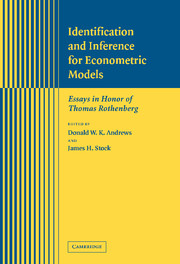Book contents
- Frontmatter
- Contents
- List of Contributors
- Preface
- Part I Identification and Efficient Estimation
- Part II Asymptotic Approximations
- Part III Inference Involving Potentially Nonstationary Time Series
- 15 Tests of the Null Hypothesis of Cointegration Based on Efficient Tests for a Unit MA Root
- 16 Robust Confidence Intervals for Autoregressive Coefficients Near One
- 17 A Unified Approach to Testing for Stationarity and Unit Roots
- 18 A New Look at Panel Testing of Stationarity and the PPP Hypothesis
- 19 Testing for Unit Roots in Panel Data: An Exploration Using Real and Simulated Data
- 20 Forecasting in the Presence of Structural Breaks and Policy Regime Shifts
- Part IV Nonparametric and Semiparametric Inference
17 - A Unified Approach to Testing for Stationarity and Unit Roots
Published online by Cambridge University Press: 24 February 2010
- Frontmatter
- Contents
- List of Contributors
- Preface
- Part I Identification and Efficient Estimation
- Part II Asymptotic Approximations
- Part III Inference Involving Potentially Nonstationary Time Series
- 15 Tests of the Null Hypothesis of Cointegration Based on Efficient Tests for a Unit MA Root
- 16 Robust Confidence Intervals for Autoregressive Coefficients Near One
- 17 A Unified Approach to Testing for Stationarity and Unit Roots
- 18 A New Look at Panel Testing of Stationarity and the PPP Hypothesis
- 19 Testing for Unit Roots in Panel Data: An Exploration Using Real and Simulated Data
- 20 Forecasting in the Presence of Structural Breaks and Policy Regime Shifts
- Part IV Nonparametric and Semiparametric Inference
Summary
ABSTRACT
Lagrange multiplier tests against nonstationary unobserved components such as stochastic trends and seasonals are based on statistics which, under the null hypothesis, have asymptotic distributions belonging to the class of generalized Cramér-von Mises distributions. Conversely, unit root tests can be formulated, again using the Lagrange multiplier principle, so as to yield test statistics which also have Cramér-von Mises distributions under the null hypothesis. These ideas may be extended to multivariate models and to models with structural breaks thereby providing a simple unified approach to testing in nonstationary time series.
INTRODUCTION
In a unit root test, the null hypothesis is that a process contains a unit root, while the alternative is that it is stationary. Stationarity tests operate in the opposite direction. The null hypothesis is that the series is stationary, while the alternative is that a nonstationary component is present; see Nyblom and Mäkeäinen (1983) and Kwiatkowski et al. (1992). Used in the context of testing the validity of a prespecified cointegrating vector, the null hypothesis is that the cointegrating relationship is true. The asymptotic distribution of the stationarity test statistic under the null hypothesis is the Cramér–von Mises distribution. When a time trend is present the distribution is different but can still be regarded as belonging to the same family. Furthermore, the test statistic against the presence of a multivariate random walk and the seasonality test of Canova and Hansen (1995) both have asymptotic distributions under the null hypothesis that belong to a class of generalised Cramér–von Mises distributions, indexed by a degree of freedom parameter.
- Type
- Chapter
- Information
- Identification and Inference for Econometric ModelsEssays in Honor of Thomas Rothenberg, pp. 403 - 425Publisher: Cambridge University PressPrint publication year: 2005
- 2
- Cited by

